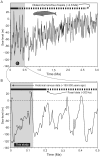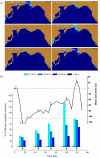What happened to gray whales during the Pleistocene? The ecological impact of sea-level change on benthic feeding areas in the North Pacific Ocean
- PMID: 21754984
- PMCID: PMC3130736
- DOI: 10.1371/journal.pone.0021295
What happened to gray whales during the Pleistocene? The ecological impact of sea-level change on benthic feeding areas in the North Pacific Ocean
Abstract
Background: Gray whales (Eschrichtius robustus) undertake long migrations, from Baja California to Alaska, to feed on seasonally productive benthos of the Bering and Chukchi seas. The invertebrates that form their primary prey are restricted to shallow water environments, but global sea-level changes during the Pleistocene eliminated or reduced this critical habitat multiple times. Because the fossil record of gray whales is coincident with the onset of Northern Hemisphere glaciation, gray whales survived these massive changes to their feeding habitat, but it is unclear how.
Methodology/principal findings: We reconstructed gray whale carrying capacity fluctuations during the past 120,000 years by quantifying gray whale feeding habitat availability using bathymetric data for the North Pacific Ocean, constrained by their maximum diving depth. We calculated carrying capacity based on modern estimates of metabolic demand, prey availability, and feeding duration; we also constrained our estimates to reflect current population size and account for glaciated and non-glaciated areas in the North Pacific. Our results show that key feeding areas eliminated by sea-level lowstands were not replaced by commensurate areas. Our reconstructions show that such reductions affected carrying capacity, and harmonic means of these fluctuations do not differ dramatically from genetic estimates of carrying capacity.
Conclusions/significance: Assuming current carrying capacity estimates, Pleistocene glacial maxima may have created multiple, weak genetic bottlenecks, although the current temporal resolution of genetic datasets does not test for such signals. Our results do not, however, falsify molecular estimates of pre-whaling population size because those abundances would have been sufficient to survive the loss of major benthic feeding areas (i.e., the majority of the Bering Shelf) during glacial maxima. We propose that gray whales survived the disappearance of their primary feeding ground by employing generalist filter-feeding modes, similar to the resident gray whales found between northern Washington State and Vancouver Island.
Conflict of interest statement
Figures





Similar articles
-
Changes in gray whale phenology and distribution related to prey variability and ocean biophysics in the northern Bering and eastern Chukchi seas.PLoS One. 2022 Apr 7;17(4):e0265934. doi: 10.1371/journal.pone.0265934. eCollection 2022. PLoS One. 2022. PMID: 35390020 Free PMC article.
-
Migratory behavior of eastern North Pacific gray whales tracked using a hydrophone array.PLoS One. 2017 Oct 30;12(10):e0185585. doi: 10.1371/journal.pone.0185585. eCollection 2017. PLoS One. 2017. PMID: 29084266 Free PMC article.
-
Distribution and demographics of mysids (Crustacea: Mysida) as prey for gray whales (Eschrichtius robustus) in northwest Washington state.PeerJ. 2024 Jan 15;12:e16587. doi: 10.7717/peerj.16587. eCollection 2024. PeerJ. 2024. PMID: 38239296 Free PMC article.
-
Is it 'boom times' for baleen whales in the Pacific Arctic region?Biol Lett. 2016 Sep;12(9):20160251. doi: 10.1098/rsbl.2016.0251. Biol Lett. 2016. PMID: 27601724 Free PMC article. Review.
-
Ecology of southern ocean pack ice.Adv Mar Biol. 2002;43:171-276. doi: 10.1016/s0065-2881(02)43005-2. Adv Mar Biol. 2002. PMID: 12154613 Review.
Cited by
-
Historical dimensions of population structure in a continuously distributed marine species: The case of the endemic Chilean dolphin.Sci Rep. 2016 Oct 19;6:35507. doi: 10.1038/srep35507. Sci Rep. 2016. PMID: 27759113 Free PMC article.
-
Multi-locus DNA metabarcoding of zooplankton communities and scat reveal trophic interactions of a generalist predator.Sci Rep. 2019 Jan 22;9(1):281. doi: 10.1038/s41598-018-36478-x. Sci Rep. 2019. PMID: 30670720 Free PMC article.
-
Recent dating of extinct Atlantic gray whale fossils, (Eschrichtius robustus), Georgia Bight and Florida, western Atlantic Ocean.PeerJ. 2019 Feb 4;7:e6381. doi: 10.7717/peerj.6381. eCollection 2019. PeerJ. 2019. PMID: 30746309 Free PMC article.
-
Incorporating non-equilibrium dynamics into demographic history inferences of a migratory marine species.Heredity (Edinb). 2019 Jan;122(1):53-68. doi: 10.1038/s41437-018-0077-y. Epub 2018 May 3. Heredity (Edinb). 2019. PMID: 29720718 Free PMC article.
-
Pre-whaling genetic diversity and population ecology in eastern Pacific gray whales: insights from ancient DNA and stable isotopes.PLoS One. 2012;7(5):e35039. doi: 10.1371/journal.pone.0035039. Epub 2012 May 9. PLoS One. 2012. PMID: 22590499 Free PMC article.
References
-
- Martin PS, Klein RG. Quaternary extinctions: a prehistoric revolution. Tucson: University of Arizona Press; 1984. 891
-
- Koch PL, Barnosky AD. Late Quaternary extinctions: state of the debate. Ann Rev Ecol Evol Syst. 2006;37:215–250.
-
- Barnosky AD, Koch PL, Feranec RS, Wing SL, Shabel AB. Assessing the Causes of Late Pleistocene Extinctions on the Continents. Science. 2004;306:70–75. - PubMed
-
- Gill JL, Williams JW, Jackson ST, Lininger KB, Robinson GS. Pleistocene megafaunal collapse, novel plant communities, and enhanced fire regimes in North America. Science. 2009;326:1100–1103. - PubMed
-
- Domning DP. Sirenian evolution in the North Pacific Ocean. Univ Calif Pub Geol Sci. 1978;118:1–176.
Publication types
MeSH terms
LinkOut - more resources
Full Text Sources
Miscellaneous

